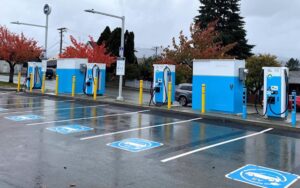New guidance from BC Hydro and Dunsky offers municipalities faster, clearer pathways to approve EV charger installations

The new BC Hydro toolkit outlines two pathways for local governments to manage installation requests.
New guidance from BC Hydro and Dunsky offers municipalities faster, clearer pathways to approve EV charger installations
Dunsky Energy + Climate, on behalf of BC Hydro, has developed a new toolkit to help local governments in British Columbia streamline the permitting process for public electric vehicle (EV) charger installations on off-street, private sites.
The Streamlining Public EV Charging Regulations & Approvals Local Government Toolkit aims to bring clarity to permitting regulations, define the process of when a permit is or is not needed, and establish responsibilities and timelines for approvals for EV charger installations.
“BC Hydro was hearing from municipalities about the challenges they were facing on how to tackle or address the permitting process,” says Hannah MacDonald, a consultant with Dunsky, in an interview with Electric Autonomy. “There are different approaches that people have been exploring, but it is still a new topic. There are a lot of questions around how to best do this, what are the best approaches [and] how are other jurisdictions doing it?”
Streamlining a new process
Because EV charging infrastructure is still a relatively new technology, municipalities often rely on outdated zoning bylaws that treat charger installations similarly to building gas stations.
This is not a fair comparison, says MacDonald, noting that building gas stations requires major construction activities and multiple permit approvals to ensure public safety, while EV installations are more straightforward.
The new BC Hydro toolkit outlines two pathways for local governments to manage EV charger installation requests.
The first recommends that municipalities either remove the need for permits altogether or introduce a “as-of-right” permitting process.
For the no-permit option, the toolkit suggests that local governments would “establish criteria… that are enforced on the basis of complaints or audits, as is common for many local bylaws.”
Meanwhile, the “as-rights” approach would allow applicants to automatically receive permits when they attest that they meet certain requirements.
“This approach could allow local governments to track EV charging deployment while offering fast approvals,” the toolkit notes.
Even with these simplified approaches, all electrical work would still require permits from Technical Safety BC or equivalent authorities, notes MacDonald. To qualify, installations must also comply with existing bylaws related to trees, signage and accessibility, and cannot involve constructing or modifying outbuildings.
For more complex projects, the toolkit recommends a Standalone Public EV Charging Permit. This is a “one-window” application system coordinated by a dedicated municipal team to ensure clear standards, timelines and accountability.
“Right now, municipalities may be receiving a handful of applications for EV charging,” says MacDonald. “But at the scale that’s needed, the process [for installing chargers] needs to withstand a four- or five-times increase in the number of applications or permits, so this [toolkit] provides a really streamlined process.”
Collaboration and growing interest
The toolkit was developed through consultation with a range of local and regional governments, including Metro Vancouver, Coquitlam, Richmond, Port Moody, and the District of North Vancouver.
Morgan Braglewicz, an air quality planner with Metro Vancouver, says the response to the toolkit has been positive from both municipal partners and EV charging developers.
“I think many are happy to be pointed in a direction they can take, especially municipalities that maybe haven’t started to think about [chargers] yet,” she notes in an interview with Electric Autonomy.
Braglewicz adds that there is a system in place, the Electric Mobility Peer Network, which allows experts and local government officials to come together to support each other as they tackle electrification projects. A peer network has been established for those interested in using the toolkit, and so far, about “a half a dozen municipalities have signed up.”
Both Braglewicz and MacDonald were also quick to emphasize that the toolkit is a resource — a guide rather than a rigid set of rules that must be fully adopted by governments.
“Part of the challenge we wanted to address is sometimes it’s not clear when an application should, for example, go through a building permit,” says Braglewicz, “The idea is that every community can establish that [criterion] in a way that fits their needs and their comfort level and aligns with their bylaws.”
Beyond B.C.’s borders
While the toolkit was designed to address the needs of local governments in B.C., MacDonald believes its usefulness can extend beyond provincial borders.
“This is a really good tool, and it’s focused on B.C. municipalities, but there are elements that could be useful for other local governments across the country,” says MacDonald. “We know that municipal staff are often stretched thin already, so anything we can do to support and streamline their work and enable more EV adoption is beneficial.”






